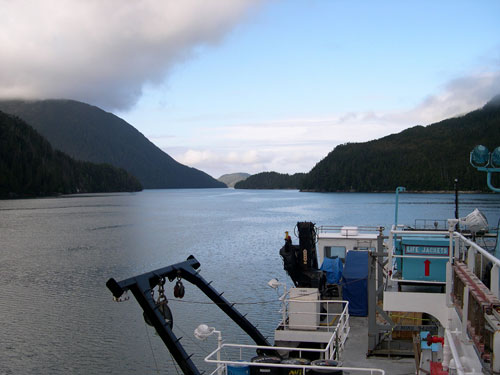 by Ned Rozell November 11, 2004
From those 30 holes, Finney pulled up cores of sediment that together add up to more than one-third of a mile. Now in cold storage in Corvallis, Oregon, that long cylinder of ocean bottom holds the history of the Gulf of Alaska.  Photograph by Bruce Finney
The continental shelf is the relatively shallow area-between about 300 and 600 feet deep-that extends from tens to hundreds of miles from shore in the Gulf of Alaska. The ocean above the shelf includes some of the most productive areas for sea life in the world. When that sea life dies, the smaller creatures sink to the ocean floor, their remains becoming a record of ocean changes. Sediment loaded with remains of resilient algae known as diatoms, for example, tells scientists that lots of diatoms lived during a certain period. If there were a lot of diatoms, there were probably a lot of fish at the same time. Finney and his colleagues used a piston-corer mounted on the 230-foot research vessel Ewing to pull up four-inch diameter cores from places like Muir Inlet in Glacier Bay. Powered by a 5,000-pound weight, the corer dropped to the bottom and grabbed plugs of history up to 60 feet long. "Some of the cores went back into the last ice age," Finney said. "We pulled up really gray, glacial sediment and drop stones (from ancient icebergs) in places where there's no icebergs today." Also captured in the cores were ancient plankton, diatoms and ash layers from the eruption of Mt. Edgecumbe that are thousands of years old. Finney will use the cores to look at the ocean's past cycles of productivity and compare the new record with what cores from Alaska and Washington lakes have told him about ancient salmon runs. He also wants to match his new ocean record with information from other scientists, such as archaeologists who comb through middens-the "trash bins" of aboriginal people of the coast-to see if he can match changes in ocean productivity to changes in the bones of fish, birds and marine-mammals left at midden sites. He'll also check for switches in the Pacific decadal oscillation, a 20 to 50-year weather period related to the Aleutian Low that stirs the waters of the continental shelf and makes them more productive. Scientists have found that when the PDO is in a certain phase, salmon thrive in Alaska and don't do as well in the Pacific Northwest. "We can sample these cores to see how repeating patterns of the last 100 years compare to the last 10,000 years," Finney said Other scientists will use the cores to learn about changes in water temperature and salinity and even flip-flops in Earth's magnetic field. While Finney and his colleagues have plenty of work ahead in cutting up and analyzing the fresh cores, they're also looking forward to a potential deep ocean-drilling project they hope the present cores will lead to. Instead of 60-foot plugs of sediment, a deep-ocean drilling program could pull up hundreds of feet of past history. "We could potentially go back millions of years," Finney said.
This column is provided as
a public service by the Geophysical
Institute, University of Alaska Fairbanks, in cooperation
with the UAF research community. Ned Rozell (e-mail)
is a science writer at the institute.
|